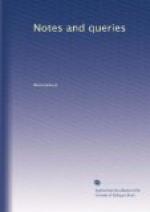Inside the ring, opposite to these letters, are the following figures for the hours:—
9 8 7 6 5 4 3 2 1
12
3 4 5 6 7 8 9 10 11
[the figures in the upper row inverted, the 12 sideways]
The small brass band was made movable that the ring-click might be properly set by the sun at stated periods, perhaps once a month.
The second sun-ring, which I bought in Stockholm in 1847, also “out of a deal of old iron,” is {53} smaller and much broader than the first, and is perhaps a hundred years older; it is also more ornamented. Otherwise its fashion is the same, the only difference being in the arrangement of the inside figures, which are as follows:—
6 7 8 9 10 11
12
8 7 6 5 4 3 2 1
[the figures in the lower row inverted]
The ring recovered by Mr. Knight evidently agrees with the above. I hope Mr. K. will, sooner or later, present the curiosity to our national museum,—which will be driven at last, if not by higher motives, by the mere force of public opinion and public indignation, to form a regularly arranged and grand collection of our own British antiquities in every branch, secular and religious, from the earliest times, down through the middle ages, to nearly our own days. Such an archaeological department could count not only upon the assistance of the state, but upon rich and generous contributions from British sources, individuals and private societies, at home and abroad, as well as foreign help, at least in the way of exchange. But any such plan must be speedily and well organised and well announced!
I give the above details, not only because they relate to a passage in our immortal bard, who has ennobled and perpetuated every word and fact in his writings, but because they illustrate the astronomical antiquities of our own country and our kindred tribes during many centuries. These sun-dials are now very scarce, even in the high Scandinavian North, driven out as they have been by the watch, in the same manner as the ancient clog[1] or Rune-staff (the carved wooden perpetual almanac) has been extirpated by the printed calendar, and now only exists in the cabinets of the curious. In fifty years more sun-rings will probably be quite extinct throughout Europe. I hope this will cause you to excuse my prolixity. Will no astronomer among your readers direct his attention to this subject? Does anything of the kind still linger in the East?
GEORGE STEPHENS.
Stockholm.
[Footnote 1: The Scandinavian Rune-staff is well known. An engraving of an ancient English clog (but with Roman characters, instead of Runic) is in Hone’s Every-Day Book, vol. ii.]
* * * * *
DISCREPANCIES IN DUGDALE’S ACCOUNT OF SIR RALPH DE COBHAM.




